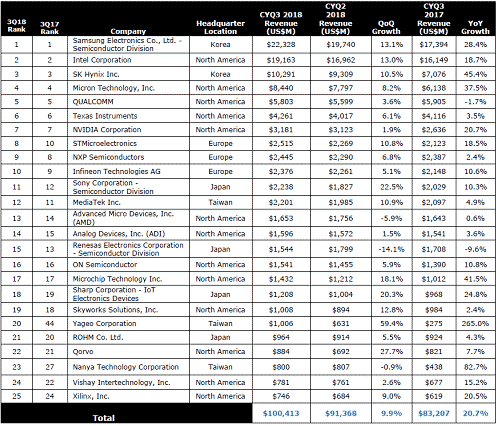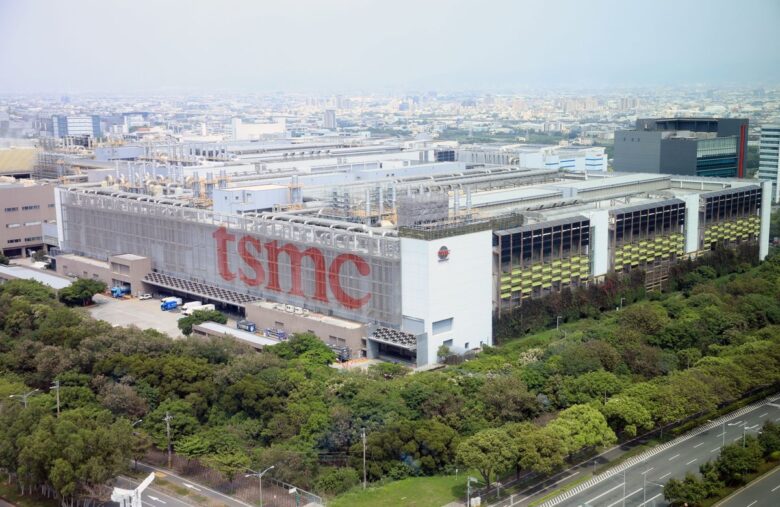For the first time, TSMC is the world’s number one semiconductor manufacturer, topping Samsung and Intel in a ranking of the top 15 global semiconductor companies for the third quarter of 2022. TSMC’s third-quarter revenue was $20.2 billion, Samsung’s was $17.2 billion, and Intel’s was $15.3 billion.
TSMC overtook Samsung and Intel to reach the top of the world.
This is based on Table 1, which summarizes third-quarter sales figures by each company from Semiconductor Intelligence, a U.S. market research firm. Although the table does not include foundry sales, TSMC took the top spot because TSMC’s sales figures have already been announced. The reason for not including foundries is as follows. However, since foundry sales = the cost of fabless and IDM (semiconductor manufacturers that design and manufacture semiconductors), the semiconductor market size is not accurate if foundries are included, and the foundry portion is double-counted. The foundries are not included in the market size of semiconductors. However, since foundries are also semiconductor manufacturing companies, it is appropriate to use the same revenue ranking.

According to WSTS (World Semiconductor Market Statistics), the global semiconductor market declined 6.3% in the third quarter (3Q) of 2022 compared to the previous quarter. Since the fourth quarter was not good either, the market is expected to fall by more than 10% in the second half of 2022 compared to the first half. This rate of decline is the largest drop since the first half of 2009, when it fell 21% compared to the second half of 2008. At that time, the impact was due to the Lehman shock, but the market recovered in just one year.
This time, the 3Q2022 decline is worse for memory makers, with Samsung down 19% QoQ, SK Hynix down 20% QoQ, and Micron down 23% QoQ. Japan’s Kioxia still looks to be fighting the good fight with a 6.6% YoY increase, but it is not merely the result of a time lag. Rather, it announced a 30% reduction in wafer input at the end of September.
Contrary to memory makers, semiconductor manufacturers focusing on chips for industrial and automotive applications are doing well, with Europe’s Infineon and STMicroelectronics doing well, up 15% and 13%, respectively. Although not listed in Table 1, leader TSMC is up 11% in dollar terms and 15% in Taiwanese yuan terms.
TSMC expects its Q4 outlook to be about the same as in 3Q, $19.9-20.7 billion. Still, TSMC is wary of the future and has reduced its investment by 20% from its original plan. For example, in 2Q2022, “70~80% of Capex was spent on 2nm process development,” said Nina Kao, the company’s top spokesperson. In other words, the most recent investments in 5nm, 4nm, and 3nm development have already been completed. Since Capex includes investment for mass production, we are only delaying investment in the next new plant, not reducing the amount,” commented CEO C.C. Wei in the financial report.
The decline in memory manufacturers is merely an inventory adjustment by users and distributors, not a reduction in investment for the future. This inventory adjustment may take a year at most, but it will only reduce inventory through production adjustments. Rather, they will remain committed to investing in semiconductors, a growth industry, for the future.
In addition, among semiconductor makers, memory makers have the largest gap between the peaks and valleys of sales: SoCs, microcontrollers, and power supply ICs use only one or two of the same product in a single system, while memory uses at least eight or nine (for parity bits for error correction) or 16 or 18 or more bytes, since memory is used in units of bytes. The amount of memory used depends on the system. The amount of memory used depends greatly on the system. For this reason, the ups and downs of foundries that manufacture SoCs and system LSIs are small.
The fact that a Taiwanese company without a foundry brand has risen to the top of the semiconductor industry means that brand power means less in the semiconductor industry than in the consumer industry. The Taiwanese business, which takes fruit over name, is finally getting bigger.


コメント